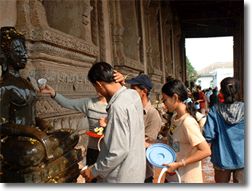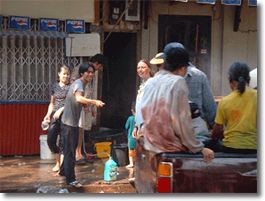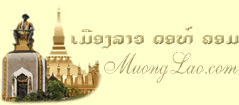Welcome
About Laos
Geography
Population
Climate
Language
Electricity
& Water
Currency
Communication
Facilities
Economic
System
Highlights
Shopping
Food & Drink
Accommodation
Travel Tips
Visa
Matters
Dos
& Donts
Getting
Around
Seeing
and Doing
Useful Links
|
 |
Lao
New Year (Pee Mai Lao)
Lao
people also enjoy the International New Year, but
Lao New Year which is called Water Festival or Koudsongkhane
is the biggest traditional festival throughout the
country.
At
the present period of time, it is organised within
the fifth month of the Buddhist Calendar, starting
from the 6th day of 5th month and ending date in
the 5th day of the 6th month. Traditionally it is
an one month festival not more or less in this specified
period. The merit day should be organised in full
moon.
Usually
Lao New Year or Koudsongkhane organised in April
13 to 16 in every year.
|
Lao
New Year History
Historically,
it was organised in the first day of January. Due
to it was winter time and uncomfortable to the waterers
and the watered so the date changed to the hottest
time of the year. Previously, there are 10 days
in Laos. The Cab is the first day, then the Hab
is the second, Hooey, Meuang, Peek, Kat, Cot, Houang,
Tao, and Kha is the tenth day, respectively.
The
months are Deuane Chieng, Deuane Nhee, Deuane Same
and so on. The first month is called Deuane Chieng
or Deuane Ay, it is nearly the same time as December.
The second month is called Deuane Nhee, it is nearly
the same period of January and the Lao twelfth months
is the same time as in the international month of
November.
There
are twelve months called Pi Xuad, the year of mouse,
Salou the of ox, Kane the year of the tiger. Tho
the year of rabbit, Malong the year of dragon, Maseng
the year of snake, Mamia the year of horse, Mamae
the year of sheep, Vok the year of the monkey, Laka
the year of cock, Cho the year of dog, and Koune
the year of boar.
Maha
Sila Viravong explained that "When Lao people immigrated
from the southern of Chaina and built their houses
in Souvannaphoum, the existing land, Lao received
culture for Lao New Year from Mon-Phama and Khmers.
Days, months and years were originally from India."
Reasons
to set up Lao New Year in the 5th month
Maha
Sila Viravong explained: During this point of time,
the day time is longer than the night from April
the 5th month to October the 11th month. Since April,
the day time will be longer than the night time
till July, the 8th month and the longest day time
of this period will be 14 hours and 24 Minutes.
The
old India respected the day time longer called Watthanasagn
(too many shadow). The sun changed to the north
direction. And the rain begins, people can produce
more than other season.
In
addition, there is an old saying that before Buddhism
there was a son of rich peasant called "Thmmaphala"
or called "Thammabane". He was a very clever boy
and understood the birds language.
At
the beginning he taught Dhamma and knowledge to
people. At the time all people respected Kabinlaphom,
the god of the sky as the wisest. When Kabinlaphom
heard that Thammabane is a powerful boy, he wanted
to make competition about the knowledge. He came
down to the world and set up three questions for
Thammabane to answer. The bid was, if Thammabane
could reply, Kabinlaphom head would be cut. It Thammabane
could not reply his head would be cut by Kabinlaphom.
|
|
The
three questions are:
- The
first question: where is the tint (bright
and lustrous) of the body in the morning?
- The
second question: where is the tint (bright
and lustrous) of the body in the day time?
- The
third question: where is the tint (bright
and lustrous) of the body in the evening?
|
|
Thammabane
could not reply immediately, but he proposed to
the postpone the date for answer within 9 days.
He thought and thought but nothing could come out.
Then 3 days passed, he went out for a long distance.
He was very tired and slept under the big palm tree.
On its branches, the big eagles talked in the bird
language and the female asked the male "what kind
of food will be for me tomorrow?" the male replied;
Oh my dear! We are going to have Thamabane meat.
The female asked "why" the male told her that Thammabane
could not answer Kabinlaphom questions and he would
be killed.
The
female birds went on to ask and the male repeated
the question as written above.
The
answers are as follows:
- The
first answer is: The tint of the body is in
the face, so people clean the face in the morning.
- The
second answer is: The tint of the body is
in the breast, so people take a bath in the day
time.
- The
third answer is: The tint is in the legs,
so people clean the feet and hands before going
to bed in the evening.
Thamabane
earful heard about these answers and remembered
the meanings. Then returned to Kabinlaphom, and
answered all questions perfectly.
Due
to the bid, Kabinlaphom cut his head to pay respect
to Thammabane. But to cut the head, Kabinlaphom
had to advice his 7 daughters to keep his head because
if his head fallen down on the land, the will be
fired. If throwing his head into the air, the drought
will come. There would be not rains and if throwing
to the ocean, the ocean will become dry.
So
his daughter took the golden plates to keep their
father's head and placed it in the cave of Khanthoumali.
Every year the girls made each turn to water their
father head and place it back in Kao Soumeloulat.
|
|
|
|
Styles
and symbols of the daughters are:
- The
1st daughter is called Thoungsathevee
Dressing
in very luxurious clothing, she likes to eat
Makdeua fruit. She brings the wheel in the right
hand and Hoy Sang shell in her left hand and
sitting on the back of the eagles.
- The
2nd daughter is called Khorakha
Dressing
beautifully, she prefers sesame for food. She
takes the sword in her right hand, a long walking
stick in the left hand and sitting on the tiger
back.
- The
3rd is called Rarksa
Dressing
with Mola and big lotus. She prefers blood.
Bringing the three pointed sword in her right
hand and in her left hand is arrow. Her symbol
is to sit on the big mouse back.
- The
4th one is called Mountha
Dressing
in Phithoune saphire and Dokchampa flowers,
she likes milk. Her symbol is to sit on the
donkey back. She takes the needle in right hand
and left hand with stick.
-
The 5th is called Kirinee
Clothing
in Morakot and Dokchampa, beans and seseam are
her favourite food. She takes the riffles in
her right and left hand with gun. Her special
symbol is to sit on the elephant back.
-
The 6th is called Kinitha
Dressing
beautifully, decorated with white sapphire,
prefer to have banana. Her symbol is to bring
the sword in her right hand sword and left hand
with mandolin. She sits on the buffalo back.
- The
7th is called Manothone
Her
clothing decorated with Sapphire. She likes
man meat. She takes the wheel in her right hand
and three point's sword in her left hand. Her
special sitting place is peacock.
All
seven daughters called Nang Sangkhane
|
|
Watering
Starting
the first day of Lao New Year, houses and
villages are properly cleaned. In addition,
perfume water, flowers are prepared. In the
afternoon, villagers gather in the pagodas
to make the Buddhist ceremonies, praying,
listening to the precepts by the head of the
monks. Then the Buddha images are placing
in the watering house. They are kept in the
opening space for three days.
Besides
the Buddha images, people watered the monks,
novices, pagoda houses, trees and others within
the pagoda.
|
 |
|
Then
for respectation the youngs water the olds,
the students water the monks for best wishes
of long lives and prosperity. Following friends
water friends. They do not only water themselves
but the houses, worshiped things, animals
and production tools are also washed by perfume
water.
Initiatively,
water festival is from the 7 daughters of
Kobinlaphom to wash their father's head. Then
the old people advised the people to wash
the Buddha images as well. Nangsangkhane ceremony
in Luangprabang and other places in Laos come
from the history of the seven sisters of Kabinlaphom.
The
respect that watering is the clean the bad
and disease away and gain the best wishes
for next year, full of long lives, clean bodies
and health. The water to be used is made by
perfume water from flowers or perfume things
from nature.
|
|
Sand Stupa
Making
There
are two ways for sand stupas making. The first
way is the monks and novices and local people
go the sand beach and make the sand stupas
as big as they like. The another way, the
villagers brought the sand from the sand beach
to make the sand stupa in the pagoda yard.
The sand stupa decorated with many types of
flags, flowers, white lime and watered by
perfume water. Finally, the sand stupas are
granted to the monks for merits making.
|
|
|
Sand Stupa can be used for construction work.
Sand stupa is the symbol of Phoukaokailat
mount where Kabinlaphom head was kept for
his seven daughters for worshipping.
|
|
|
Animals
Liberity
The
provisiong of animals liberty is let the animals
to free. This practice is to show the best merit
making. The animals to be freed are: tortoises,
fish, crabs, birds, eels, shell and so on. Some
free the lives of animals as the same amouth of
their ages. To free the animals is to give them
lives. It is likely to protect the forest and environments.
Flowers
Collection
Traditionally,
Lao people collect the fresh flowers for the Buddha
images. Some collected the flowers from the forests
near by villages this practice is being done in
the rural villages.
Fresh
forest flowers collection is made in the afternoon.
The head of the monk guide the monks, novices, nuns
and villagers to the forests where many types of
forest flowers could be collected. Traditional drums
and other music instruments played. On the way back
to the pagoda, the villagers who do not take part
in the forest, brought many basketful of water for
flowers washing.
In
the evening, the olds and youngs gather in the pagodas
for entertainment.
If
any villages place the Buddha images in the caves
of the mountains, Song Namphaphou, water the Buddha
images in the mountains is called. It is like a
picnic, sometimes monks and the villagers had lunch
in the mount where running water is available. In
some rural villages, the Buddha images are place
more than three days for watering. Baci ceremony
for Buddha images is being performed in some rural
villages.
|
|

